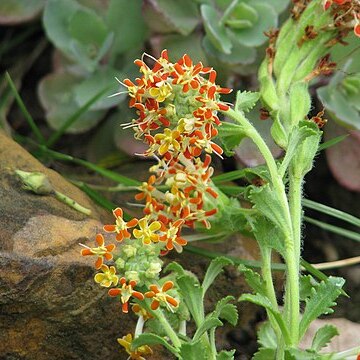Tufted perennial herb or subshrub, stems erect or decumbent then erect, 150-600 mm high, mostly simple but with dwarf axillary shoots that sometimes elongate, these usually sterile, pubescent with long acute hairs and short-stalked glands, closely leafy. Leaves opposite, subopposite or alternate above, mostly 15-37 x 5-16 mm, decreasing in size upwards, roughly half the length petiolar, blade narrowly to broadly ovate or oval, obtuse to subacute, coarsely crenate-serrate to almost lobulate on margins, at base narrowed into the flat petiolar part, expanded and half-clasping, thick-textured, both surfaces pubescent with long acute hairs and short-stalked glands or, more usually, upper surface thinly pubescent, hairs confined to margins and main veins below. Inflorescences turbinate initially, c. 25-30 mm long, mostly solitary, sometimes subtended by smaller spikes on short leafy axillary shoots, spikes elongating in fruit. Bracts 8-15 x 2.5-5 mm, oblong, abruptly acute, entire, backs and margins pubescent with long acute hairs and short-stalked glands, less hairy within. Calyx 4.5-6.5 mm, membranous, obscurely bilabiate, lobes 1/3-1/2 the length of the tube, free nearly to the base anticously with long delicate acute hairs and short-stalked glands on backs and margins, glandular-puberulous within. Corolla tube 13-17.5 mm long, c. 2 mm broad, dilated under the limb, creamy; limb slightly irregular, 6-8 mm diam., lobes oblong to suborbicular, bright orange inside, buff to brownish outside. Stamens all exserted, anthers equal. Capsule c. 6 x 3 mm, seeds many.
More
Perennial herb or dwarf shrub, stems ± simple, erect or decumbent first, up to 600 mm high. Leaves up to 37 x 16 mm, ovate or oval, apex various, margins roughly crenate to serrate or ± lobed; shortly pubescent; ± 1/2 length of flat petiole. Flowers in a single, obconical head at first, up to 30 mm long, lengthening in fruit. Calyx: lobes up to 1/2 length of tube. Corolla: tube up to 17.5 mm long, cream-coloured; limb ± regular; lobes orange inside, light brownish outside.

